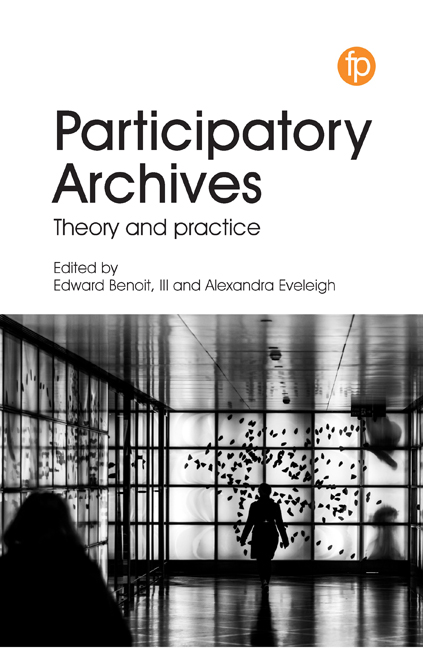Book contents
- Frontmatter
- Contents
- Figures and table
- Notes on contributors
- 1 Defining and framing participatory archives in archival science
- SECTION 1 SOCIAL TAGGING AND COMMENTING
- SECTION 2 TRANSCRIPTION
- 6 Engaging curation: a look at the literature on participatory archival transcription
- 7 Subtle transformations: increasing participation and access through transcription
- 8 Crowdsourcing metadata for time-based media in the American Archive of Public Broadcasting
- 9 Participatory transcription in Amsterdam and Copenhagen
- SECTION 3 CROWDFUNDING AND OUTREACH
- SECTION 4 ALTERNATIVE AND ACTIVIST COMMUNITIES
- Notes
- Index
8 - Crowdsourcing metadata for time-based media in the American Archive of Public Broadcasting
from SECTION 2 - TRANSCRIPTION
Published online by Cambridge University Press: 25 October 2019
- Frontmatter
- Contents
- Figures and table
- Notes on contributors
- 1 Defining and framing participatory archives in archival science
- SECTION 1 SOCIAL TAGGING AND COMMENTING
- SECTION 2 TRANSCRIPTION
- 6 Engaging curation: a look at the literature on participatory archival transcription
- 7 Subtle transformations: increasing participation and access through transcription
- 8 Crowdsourcing metadata for time-based media in the American Archive of Public Broadcasting
- 9 Participatory transcription in Amsterdam and Copenhagen
- SECTION 3 CROWDFUNDING AND OUTREACH
- SECTION 4 ALTERNATIVE AND ACTIVIST COMMUNITIES
- Notes
- Index
Summary
Background and the problem
The number of audiovisual materials is increasing daily. A Wall Street Journal article from February 2017 reported that more than 400 hours of content are uploaded to YouTube every minute.1 Archives collecting historical materials are increasingly acquiring more audiovisual content. The metadata needed to describe this material is increasingly inadequate, particularly with older materials. Cataloguing is labour intensive, and archives do not have the resources and staff to catalogue their collections fully. Cataloguing audiovisual materials is particularly time-consuming, more so than static text and photographs. A textual document or photograph contains one image while moving images can contain thousands of individual frames. Audio is even more time-consuming, as there is no visual component that allows you easily to ‘scrub’ through the time-based media for visual cues. Yet cataloguing is critical for access and discoverability.
The American Archive of Public Broadcasting (AAPB) is a collaboration between the Library of Congress and Boston public broadcaster WGBH Educational Foundation.2 Its mission is to co-ordinate a national effort to preserve at-risk public media before the historical content is lost and provide a central web portal for access to the unique programming public stations have created over more than 70 years. Established in 2013 by the Corporation for Public Broadcasting, the AAPB has digitised more than 50,000 hours (90,000 items) of programming and original materials and is growing annually. The entire collection is accessible on location at the Library of Congress and WGBH, and since 2018 more than 35,000 programmes are accessible online via the AAPB's Online Reading Room to anyone in the USA (currently limited for copyright reasons).
A content inventory project and a subsequent digitisation project kicked off the AAPB. Staff at 120 public media stations inventoried the tapes held at their station, from broadcast programmes to original materials. Station staff transcribed the information written on tape labels, such as titles, dates, generation and duration. Sometimes this information was inaccurate, illegible or did not exist. Staff at 100 of those stations then selected items from their inventories for digitisation, which created the initial AAPB collection.
When managers at WGBH and the Library of Congress began planning the next phase of the AAPB initiative, normalising and enhancing the inventories became a priority. The AAPB faced a massive and growing collection of digital video and audio files with incomplete metadata.
- Type
- Chapter
- Information
- Participatory Archives , pp. 95 - 102Publisher: FacetPrint publication year: 2019



